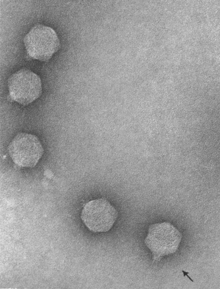Pseudomonas virus gh1
Pseudomonas virus gh1 (Bacteriophage gh-1) is a bacteriophage capable of infecting susceptible strains of Pseudomonas putida.[1] It is a member of family Podoviridae, subfamily Autographivirinae.[2] It was first isolated in 1966 from a sample taken from the aeration tank at a sewage plant in East Lansing, Michigan.
| Pseudomonas virus gh1 | |
|---|---|
 | |
| Electron micrograph of bacteriophage gh-1 negatively stained with uranyl acetate. Magnification X 300,000. Two fibers attached to the wedge-shaped tail are visible on the bacteriophage, as indicated by an arrow. | |
| Virus classification | |
| (unranked): | Virus |
| Phylum: | incertae sedis |
| Class: | incertae sedis |
| Order: | Caudovirales |
| Family: | Podoviridae |
| Genus: | Teseptimavirus |
| Species: | Pseudomonas virus gh1 |
Sedimentation analysis indicates that gh-1 carries its genetic payload in the form of a 37,359 bp linear strand of dsDNA,[3][4] inside an icosahedronal capsid 50 nm in diameter.[1]
One-step growth experiments indicate that the latent period is approximately 21 min, with a burst size of 103.[1]
It has been shown that this phage group requires an intact O-antigen on its host's outer membrane in order to successfully replicate and it is thus likely that lipopolysaccharide acts as the phage receptor.[3]
References
- Lee, L.; Boezi, J. (1966). "Characterization of bacteriophage gh-1 for Pseudomonas putida". Journal of Bacteriology. American Society for Microbiology. 92 (6): 1821–1827.
- "Virus Taxonomy: 2018 Release". International Committee on Taxonomy of Viruses. Retrieved 2018-12-07.
- Kovalyova, I.; Kropinski, A. (2003). "The complete genomic sequence of lytic bacteriophage gh-1 infecting Pseudomonas putida - Evidence for close relationship to the T7 group". Journal of Virology. 311 (2): 305–315. doi:10.1016/S0042-6822(03)00124-7. PMID 12842620.
- Lee, L.; Boezi, J. (1967). "Sedimentation Analysis of Pseudomonas putida A.3.12 Bacteriophage gh-1 Deoxyribonucleic Acid". Journal of Virology. American Society for Microbiology. 1 (6): 1274–1276. PMC 375419. PMID 5621492.
External links
- "Pseudomonas putida bacteriophage gh-1 ATCC ® 12633-B1™". - ATCC database entry for gh-1
- "Pseudomonad phage gh-1". - Virus-Host Database